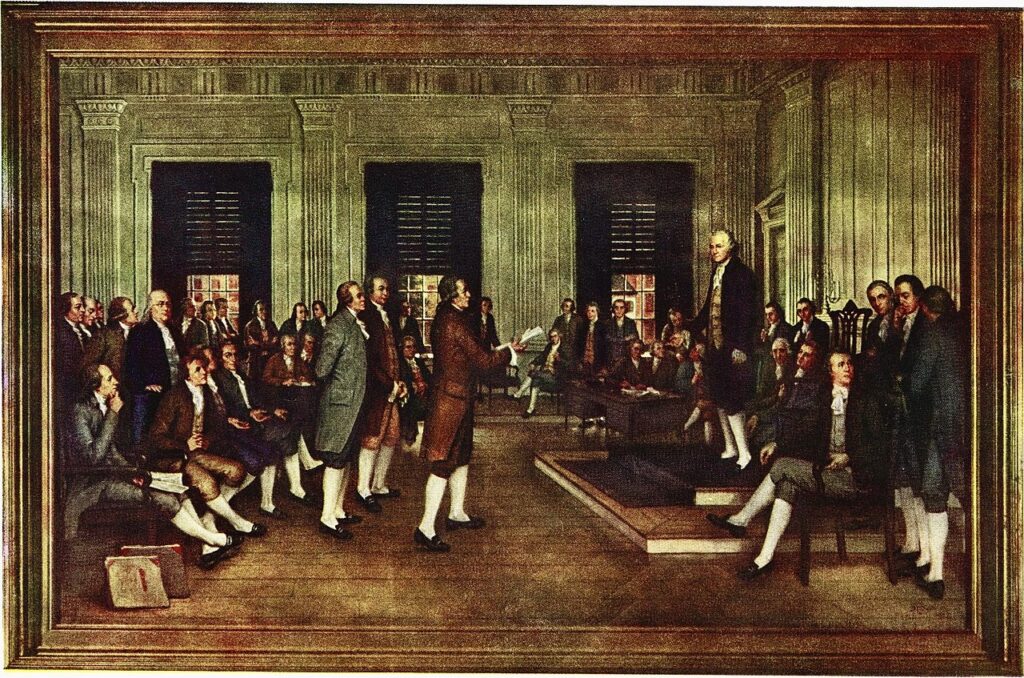The Adoption of the U.S. Constitution
by John H. Froehlich

Courtesy of the State Museum of Pennsylvania, Pennsylvania Historical and Museum Commission.
Artist’s Biography
John H. Froehlich (1870-1945) was born in Harrisburg, Pennsylvania, and studied at the Philadelphia Academy of Fine Arts before returning to Harrisburg. There he worked primarily as a portraitist, painting prominent citizens and state officials. He served as secretary of the Harrisburg Art Club for many years.
The Painting
This painting, completed by Froehlich in 1935, hangs in the Pennsylvania State Museum in Harrisburg. According to N. Lee Stevens, the senior curator of art collections at the State Museum of Pennsylvania, “The artist painted this under the CWA [Civil Works Administration] and FERA (Federal Emergency Relief] . . . programs employing artists to aid museums.” Stevens kindly provided us with an identification of each of the delegates portrayed in this painting. This version of the painting comes from pages 68 and 69 of a two-page advertisement from 1942, printed in an unidentified magazine by Westinghouse Electric and Manufacturing Co., located in Pittsburgh, Pennsylvania. (We believe that the ad first appeared in the February 9, 1942 edition of Life.)
The advertisement is entitled, “We think this is what they meant.” Froehlich’s painting appears on the left-hand side of the two-age spread, on page 68. The right-hand side, on page 69, speaks to Americans living during World War II, claiming to explain what “they,” the Founding Fathers of 1787, meant by the phrases “to provide for the common defense [and] to promote the general welfare,” in the Preamble of the Constitution. The ad lists 12 contributions of Westinghouse “know how” to the “common defense” and 12 more contributions to the “general welfare.”
The Delegates
Froelich depicts 40 people in his “Adoption” painting. He places Washington higher than any other figure, giving him clearly recognizable features. Figuring prominently in his design are the windows in Independence Hall, presented here as half shuttered, and the rising sun chair made popular by Ben Franklin’s famous closing remarks at the Convention. (The assemblage of delegates at the adoption is incorrectly identified as the “Congress.” It should be the “Convention.”)
Franklin is also easily recognizable; he is standing prominently in the group at the left of the painting. Three other delegates are prominent. They are in the middle forefront, between Washington and Franklin. But who are they? According to curator Stevens, they are Pennsylvania delegate James Wilson, Massachusetts delegate Nathaniel Gorham, and South Carolina delegate John Rutledge. And who is the studious-looking delegate in the left foreground, finger on chin, feet crossed, document on lap, with two volumes on the floor next to him? Apparently it is James Madison.
Author’s Note
(It is interesting to note the copy on the reverse pages of the advertisement. On the back of the Froehlich painting, page 67, is an advertisement for the 1942 Royal Desserts Recipe Book, giving a deadline for submissions of 31 May. On the back of the Westinghouse commentary, page 70, is a story about seven loyal Japanese Americans in the U.S. Army who are teaching jujutsu techniques to 100 U.S. army trainees at Camp Roberts, California.)
